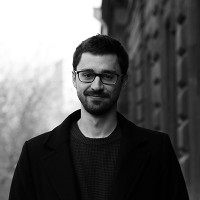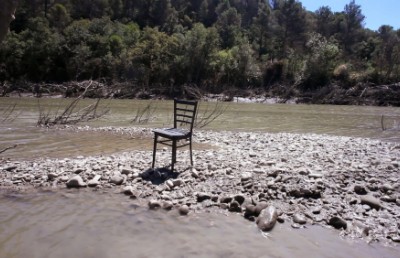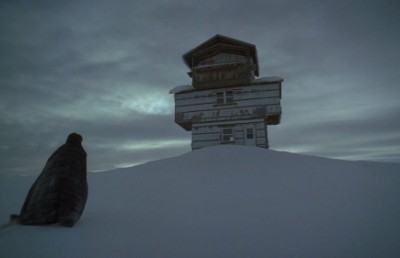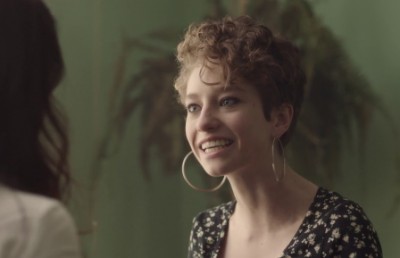RIDM: Interview with Oksana Karpovych, director of Don’t Worry, The Doors Will Open
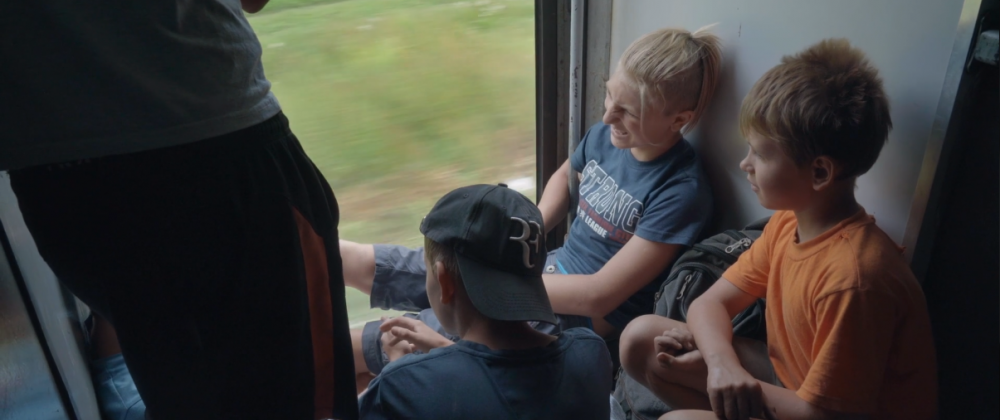
A newspaper salesman, whom we’ve seen working on a train before, welcomes the crew to his house. Like many older people in post-Soviet countries, he does a job that may not resemble anything he did before borders moved. And like many other elders there, he doesn’t know what it’s like to enjoy retirement. But if he’s sad or disappointed, he hides it very well. He has energy for a while and shows it every day. And he takes it with humor. Although life is harder in Ukraine than, for instance, in Canada, it doesn’t take away his sleep. “Extremes are more fun,” he confesses. He knows it well, as he travels on the same trains of probably forty years ago, and his pension forces him to continue working despite his age.
This is one of the many encounters featured in Don’t Worry, The Doors Will Open (Oksana Karpovych, 2019), Oksana Karpovych’s first full-length documentary. Some people talk, others prefer to keep quiet, go on with what they were doing, or do as if nothing had happened. Some tell their testimonies, but prefer not to be filmed. There are cheerful stories, while others are rather tragic. People of all ages take those trains that don’t go out of fashion and continue to serve a basic function for a large part of the population. Not without reason were they called “workers’ trains”, as Karpovych mentioned in the Q&A of her first screening. Trains of Soviet manufacture that still have a long way to go before they become part of a museum. Like that image of old people carrying bags or selling goods. A scene that will not change as long as many other things do not change in the country.
We spoke with the Ukrainian director at the Cinémathèque québécoise, after the world premiere of her film at the Montreal International Documentary Festival (RIDM), for which she ended up receiving the award for best film in the New Visions Competition section.
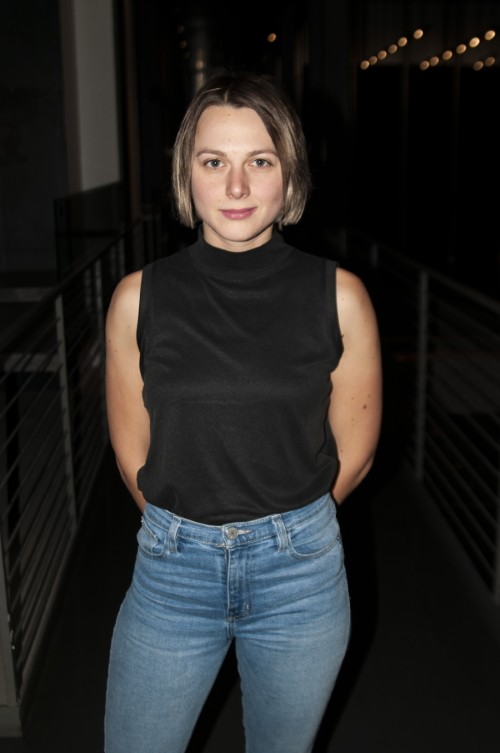
Oksana Karpovych
Offscreen: Where does the idea of the film come from?
In the Q&A there was a question about this. It’s kind of banal and at the same time it’s not. It started when I immigrated here, because when I came to Canada I was feeling very nostalgic. Immigration is a rupture, it’s a cut from your roots. On the one hand it’s a very traumatic experience and on the other hand it’s something that gives you a chance to look at your own background and history and rethink your own identity. So, basically, to help yourself reconstruct your new identity you need to understand better what you were before. I think that was the impulse, something that pushed me to think about my childhood, my background in Ukraine. During this thinking process I realized that those trains, the electrichkas, would always just pop in my mind and in the beginning I didn’t understand why there were so important to me because it’s such a trivial thing in Ukraine. So, then I had to go to Ukraine, do research and try to understand why I am so attracted to them, and I think I’m still trying to understand. And now when I’ve made the film it’s nice to hear people’s reactions because I’ve got to know my film better. Sometimes they point at things that I had not realized before. So, in brief terms, this was like the first impulse that pushed me to make the film.
Offscreen: Do you think there are aspects that you only see or think about once you leave your country?
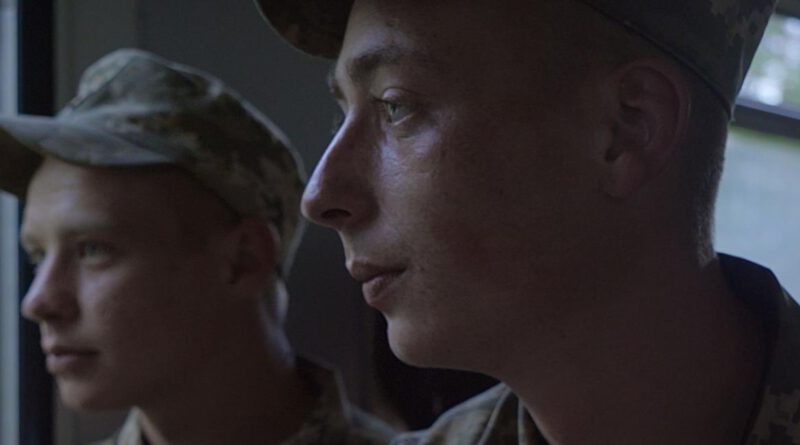
I think that this distance, and it doesn’t need to be immigration since it can be any kind of travel, is definitely a privilege. Having this distance from your own culture, from your own society… gives you this tool and sort of space to look at yourself and your society from this new perspective from which you could never see it before. It’s the same when we travel abroad, we see the other countries from a different perspective that local people don’t see. So, I think it’s a big privilege and I’m definitely thankful to have it, and as I said it’s kind of traumatic and painful to be far and to see these things that you didn’t see before. Sometimes it’s like horror, all this abuse of people’s rights or abuse of power that you didn’t realize when you were in your country, but from afar you see better and you see how the politics affects people’s everyday life. And when you are inside you are too close to see it.
Offscreen: Are there other aspects that you realized after hearing the people’s comments here?
So far, I had only two screenings. It’s interesting because in the beginning, when I started making the film, the first people who saw it, people who have never traveled to Ukraine, found it depressing, while for me there it is definitely a sadness that is associated to all these problems that our society faces in Ukraine. On the other hand, there is so much beauty and so many things that are missing here, that are very unique, powerful, but people somehow don’t see, because they are not much exposed to other cultures. Again, this distance gave me the opportunity not to see just bad stuff, but to see the beauty of my people, my country. The subject I’m filming is not the most attracting, it’s not something you would go to see in Ukraine, those trains. It’s not either the people you would necessarily would want to meet, however I find them very beautiful.
Offscreen: Even if there are sad stories, like the two testimonies we hear but whose protagonists we don’t see in the film, I think it’s a cheerful film.
I think the conditions and the life are pretty tragic actually. But the way I portray them, the way I see them, and the way some of my characters see them is very ironic. For example, the newspapers’ seller. One of the reasons I wanted to film him is because I find him very self-ironic: he can laugh, not just at the things surrounding him but also at himself, being a victim of the corruption and these human conditions in which he lives. The only way he finds the energy to survive and live every day is humor, to be self-ironic. And I think this is a powerful tool that we should use whatever hard the situation we face in our life, in whatever country. I think that I was trying also to be a bit ironic in the film, to use some humor, because for me it is sad.
When I was working, many times it was actually very painful to see the struggles of my people. Often it feels there is no way out, there is nothing I can do as an individual, specially being far, so what helps sometimes is love.
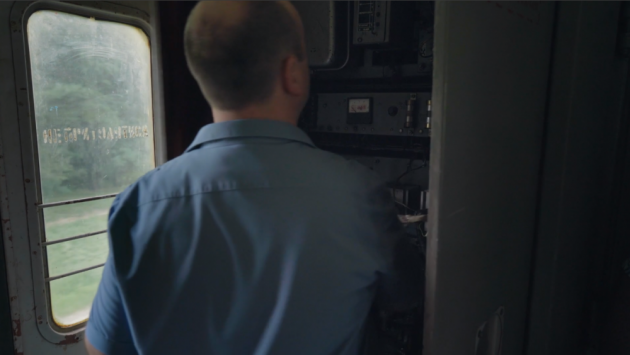
Offscreen: The newspapers’ seller scenes are some of the deepest moments in the film. Even if there is no a protagonist in the film, we see him often and, somehow, he is one of the main characters. Do you agree with him when he says that the extremes are more fun?
It’s a very ironic comment. People that have not lived in countries like mine, that never traveled there, find it hard to understand the intensity of our countries. Ours is like Mexico or any Central or South American countries. I have friends coming from these regions and I often find this in common. What we miss is this intensity in life, which is very difficult to translate, and I guess that’s why I use these cinematographic tools to show it, since it’s something impossible to explain. That’s what you feel there all the time, especially when you have the contrast, when you come to Canada and everything is nice and proper, people are very polite and the transport system works well. When you go there it’s overwhelming, it’s very intense, even if it works well, people have this kind of intensity.
Offscreen: Is it more boring in Montreal?
Well, I’ve been here for six years. I’m less inspired by Canadian subjects. One reason why I started working on Ukrainian subjects is because it’s not just that I can relate to it, but also because it’s inspiring because of its intensity, It’s very challenging, in a way. I know that Canadians find it insulting sometimes, but life here is a little flat, you know? Maybe in Europe is different, that’s something we share the Europeans, the intensity…
Offscreen: Do you think that the audience can have an overview of the life in Ukraine thanks to your film?
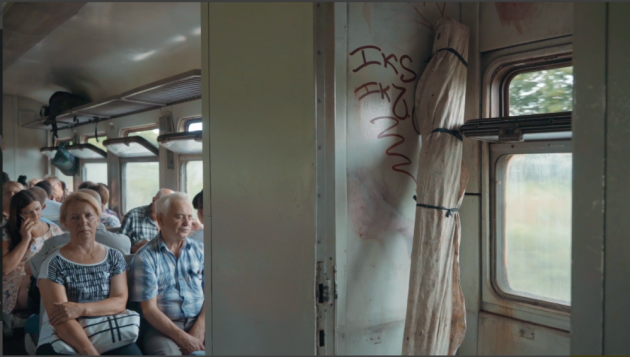
Yeah, definitely. That was one of the things that I wanted to show, how the majority of the country lives, because what we know about Ukraine is mostly related to big dramas, like the Maidan Revolution, the war, now the discussion about Trump, Chernobyl… When we hear about Ukraine it’s always related to really big issues. We never know what is behind them, what’s the life of the regular people, their everyday life, so I wanted to show, to create this kind of collage of all kinds of people, but really concentrate on the working class, the people that sustain this country. And I think it gives a good overview, because I had access to so many people, I had so many characters, and each of them brings some new information of the country. Just observing someone we can learn something about the society, the social interactions or the culture.
Offscreen: Is it more a film about the people or these Soviet trains or the interaction between both of them?
For me it’s definitely not a train-film. And, actually, it’s interesting the way the festival describes the film and places it in this genre, that I don’t even know if it exists. It’s about everything you imagine, it is the social interactions between people. In a way it’s an ethnographic portrait or anthropological study. On the other hand, there is a political layer. And I was very curious to explore and show how the politics, social and economic situation in the country affects the everyday life of this regular people.
Offscreen: Why did you choose to shoot in these Soviet trains and not in the new ones?
Because of the nostalgia for those trains I used to take. But another reason is that I feel that the people I film is on the margins, they are kind of forgotten, even in Ukraine. I’m coming from the suburbs of Kiev and my friends are mostly coming from these areas too. I studied at the university in Kiev. If you go to Kiev you go to downtown and you will think you are in a very beautiful city and country, very modern, with lots of cafes and it’s pretty cool, you have access to everything like in any European capital. But once you go to the outskirts of that capital you see a very different picture. Even my friends who live in Kiev sometimes have very little knowledge about those who live next to them but in the outskirts. So, I really wanted to pay attention to that part of the society and those kinds of boring places that don’t have any importance for those who live in big cities, but where the majority of the population live. For me, this is the actual face of Ukraine.
Offscreen: Can you tell again what you mentioned in the Q&A about this newspapers’ seller?
We went once to his place. That was the only person that we wanted to see in his domestic environment. At the beginning I just wanted to focus on the trains but to have some sort of consistency in the film and remain static, without leaving the trains or stations. But at the end, because I’ve been working on the project quite a long time, I got bored and I wanted another layer, something else. I was getting closer and closer to people so it looked more natural, just going deeper and following them somewhere. I didn’t do it much, sometimes I tried and didn’t work, but with him we really had a strong relationship. He was very welcoming, open. The encounter was very brief but it was a kind gesture from him. At some point it felt like a collaboration. You could see he was interested in what we were doing. He’s not just a passive subject in the film. He is a participant. So that was cool.
Offscreen: Do you value that the Ukrainian people that attended your first screening liked the film so much?
Yes! I kind of knew they would like it. I think I really wanted to put so much love in the film that I think I made this film because of my love to those Ukrainian people. So, I’m not surprised that they recognized themselves in these characters and that they felt this love, because I tried hard to convey it. Of course, I’m very happy with this reaction. And it was a premiere and it was very emotional and I’m actually very curious to know what people think about the film when they are less emotional. I hope they will think sometimes about it and I wonder if they will think about Soviet times and other subjects that the film raises, like the 90’s, the Ukrainian independence, the current political situation… It’s something they didn’t address in the Q&A, they were probably thinking: “this is the train of my childhood”. It was very romantic. They first had this reaction to the romantic element of the film or that life, but I’m sure there are other levels of the film that could be interesting to discuss. So, we’ll see if maybe in other screenings or in other circumstances I will have a chance to hear deeper thoughts about the film.
Offscreen: What do you think are the main issues or problems that, in your opinion, the film raises?
I think it’s the poverty. First of all, the economic situation that exists in the Ukrainian society right now. The fact that people cannot afford better transportation, better food or food at all, that they have to do all kind of jobs to survive. This concerns all the people. Most of the people we see in the trains are old, it’s the generation that lived most of their lives in the Soviet times and now they are struggling to, basically, survive in the current situation. They just lost their jobs; they used to have jobs in the Soviet times and in the 90’s they lost everything. Now they are still dealing with the results of the collapse of the Soviet Union because it was not resolved. And it’s not their fault. It’s the fault of every Ukrainian government. It’s not the problem of our president, it’s a problem that existed throughout the Ukrainian independence. No one ever created those work places, tried to rebuild the Soviet heritage, brought back those factories. But no one actually tried to bring up the life conditions of the regular people. So, this is the biggest thing. But then there are others, the history and the Soviet past, the Soviet heritage, this nostalgia for the Soviet times. The train is kind of a subject, but in the end it’s not the primary subject of the film, it’s just a pretext to entering in their lives. We can still talk about the train we see in this film, but it would be a completely different discussion.
Offscreen: And what are the main issues of Ukraine today?
Well, the same that I just described. Plus, the war. Yeah, I guess I didn’t mention something I should not forget, that is actually the most important. The war is still the main issue of Ukraine and it’s very easily ignored when you are not dealing with it personally, but it’s the main reality of the country. It’s not resolved. Every day there are injured or killed people. Every day we hear in the news about the victims. There is still military pression from Russia in the east of Ukraine. Part of Ukraine is still annexed. There are things that are not resolved. It’s been almost five years and no one does anything. I would say that right now the biggest discussion in Ukraine is the new agreement that the current president wants to sign, which is called Steinmeier Formula. But there is a lot of foul play because people feel that the president is capitulating, giving up. So, right now, this is the biggest issue and while the whole world talks about Trump, inside Ukraine people mostly talk about the war situation, because it’s something way more troublesome for us. I’m not even sure if this discussion about Trump helps us because sometimes it draws so much attention that these other problems are hidden. On the other hand, there was another conversation that Trump had with our president about if the US should give military support. I would say those are the main issues today in Ukraine.
Offscreen: Talking about the production, how did you find a producer here and at what point they became involved?
I pitched the project here in RIDM in a program where young filmmakers can present their ideas in front of producers. This is how I found a producer. There was a workshop and I didn’t know that I would actually pitch the project to them. All I had was a brief description of what I wanted, and photographs. I didn’t have a single video. Because I didn’t know. I was just thinking that I could make this film in the future. But it worked. People liked the idea, there were other producers interested and the photographs were kind of convincing. So, this is how it started. It was actually interesting to work with Canadians because I had to explain the nuances of Ukrainian culture, to prepare them for my shooting, so they could understand why I needed this and that, and why… For example, it was so important for me to work with this cinematographer and not any other. He is English but he used to work in Ukraine for six years. It’s been a quite long process but, in the end, we succeeded. I wonder if I could have made this film in Ukraine because we have very limited funding for films, and it’s kind of corrupted, from what I know. They really support fiction, especially. They often give the funds to some relatives or something… So, I don’t know if I would have ever made my film in Ukraine. I’m very lucky.
Offscreen: Can you tell some anecdotes, something we didn’t see in the film?
Some people ask me what was the hardest thing in the film. And I forgot to mention that it was sometimes hard having to drink very cheap bad quality cognac. It’s something you sometimes have to do in the trains with the people you are filming. Ukrainians are very generous. Especially when it comes to food, it’s something that people are crazy about. They really want to share and they don’t understand what is “no”. So many times, we, mostly me and my cinematographer, had to have one or two shots of cognac and to show that we appreciate their generosity. But, of course, it’s just a little funny thing. In addition, it was actually funny when we were filming the long shot in the station when the passengers were getting off the train and coming towards the camera. We spent the evening filming those people, but the initial idea was to make an improvised crane shot of the crowd. Of course, we didn’t have a crane so we took a baby carriage that I had borrowed, we put the camera inside, so the cinematographer could walk with it between the people filming in a way they wouldn’t understand. You could still see that the camera was there but people wouldn’t pay much attention. Sometimes it is not the first thing they see, but after they do and they laugh. It actually helped us. That was funny.
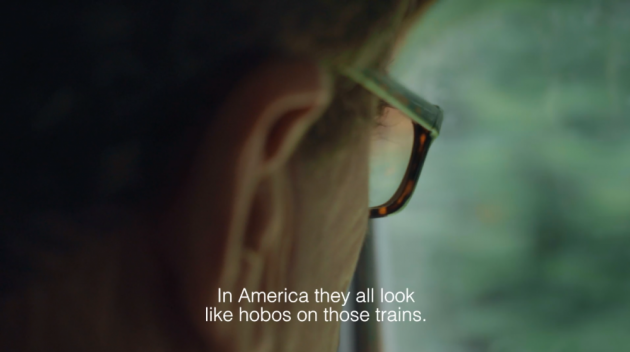
Offscreen: How many hours of material did you have? Was it hard to choose the fragments?
We didn’t have that much for a documentary film. Maybe sixty hours. I think I didn’t mention it, but through the whole process the hardest thing was that there is not a main narrative, no main character or characters. Technically it was hard because we always changed from train to train, day and night. During the day it’s cloudy or sunnier, so inside the train sometimes the wagons look differently, the train moves in different directions… it was something I didn’t realize while filming. And when we started editing we realized that sometimes we cannot stick one image to another because they are not consistent. So, it was hard to find the way to edit the film, to find the structure of the film that doesn’t have the obvious beginning or obvious formulation… There are no big dramas, nothing you can really stick to the classical structure. But we worked hard and, in the end, we treated the film more like a musical piece. We realized that the most important thing were the variation and the rhythm. You would just change from place to place to keep the people’s attention, not to lose what is new and unexpected… At the end, that was the decision.
Offscreen: To finalize, what would you say to a person that didn’t watch the film yet, as a way to attract their attention.
I think people often describe this film as a train-film. But it’s a very personal film. And the fact of being a personal film affects the way it is made. I think the form is special and we really wanted to avoid clichés. We didn’t have any rules or limits, regarding how we wanted to talk to people, trying different things and mixing up different elements. I think it’s personal and emotional and very subtle while talking about very important subjects. That’s something that I would pitch to the audience.

